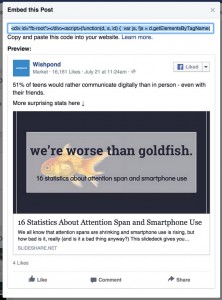Okay, so you’re convinced that your business needs an explainer video to bolster your digital marketing strategy. You’ve seen the influence of video marketing and realize that it’s time for your company harness the power. This is all great news. But here’s what isn’t such great news: now you need to convince your fellow stakeholders that producing an explainer is important so that you can all move forward together.
Persuading any group of people towards a single decision is difficult, let alone when that group of people likely includes employees from different divisions and/or disciplines. So what’s the best way to get their ear? What’s the most efficient way to make a strong case? How can you persuade them about the importance of an explainer video?
These are the types of questions we’ll seek to answer today and tomorrow as we look at a variety of ways to persuade stakeholders than an explainer is important.

1. The Persuasive Power of Numbers: When it comes to the business world, there’s rarely anything more compelling than cold, hard numbers. Luckily, when it comes to the power of explainer videos, there are plenty of impressive stats to back up their importance.
Each of these posts contains several persuasive bits of information but, taken together, these stats in particular really stand out:
- The average user spends 88% more time on a website with video (Mist Media). And visitors who view videos stay on web sites an average of 2 minutes longer than those who do not. They are also 64% more likely to make a purchase (ComScore)
- According to Wyzowl’s survey, “The State of Video Marketing in 2016,” 61% of businesses stated that they currently use video as a marketing tool. The survey also revealed that 93% of businesses who use video believe it has increased user understanding of their product or service. The survey also notes that 98% of users say that they have watched an explainer video to learn more about a product or service.
- According to AOL’s 2015 State of the Video Industry Report, digital ad spending for the year was estimated to top $ 58 billion; up nearly 14% from 2014. “This growth shows no signs of stopping,” states the report, “with digital spend projections reaching $ 93.7 billion by 2019, and much of that growth acceleration coming from digital video.”
- AOL’s 2015 State of the Video Industry Report also notes that 9 in 10 buyers are shifting dollars from Linear TV to digital. Of the marketers moving towards digital channels, 88% are shifting that television spend to some form of video. In particular, 55% noted part of that reallocation would go to mobile video.
- According to a survey conducted by the Web Video Marketing Council, 96% of B2B organizations are engaged in video content marketing. In addition, 73% say that video has positively impacted marketing results.
With figures like these, you’re likely to get the attention of several stakeholders. But perhaps more important than the numbers alone is the larger trend they point to: video marketing is here to stay and it’s growing by the day. Which leads us to another tool that can be used to persuade fellow decision-makers…
2. Fear of Missing Out: As evidenced by some of the statistics above, a significant number of businesses have jumped on the video marketing bandwagon. If your company has not yet gotten on board, then there’s a good chance that many of your competitors already have. While this may be frustrating to you, as someone trying to rally your colleagues, it’s a reality that you can use to your advantage by playing up the “fear of missing out.”
You’ve likely heard of FOMO, or fear of missing out, in a colloquial context (i.e. social media), but there’s a psychological basis that’s been touched on in several economic-related studies. For example, in a paper entitled Loss Aversion in Riskless Choice, published in 1991 by Amos Tversky and Daniel Kahneman, these behavioral economists use psychology to discuss decision theory. Among many things discussed in the paper, their research suggests that losses are twice as impactful on people (psychologically) as gains.
This type of aversion to risk might actually even be one reason that stakeholders are less interested in exploring the possibility of an explainer video than you are. Status quo is often the easier way to go. But by framing your position in comparison to the competition, you can likely yield a different reaction from your colleagues. At the least, it’s an effective way to confront the larger conversation: what are we doing, and we should be done, to ensure that we maximize our resources?

3. Demystify the “Process”: While the fear of missing out is something you can use to your advantage, an abstract fear about the “process” is something that you might need to quell. That’s because even if your fellow stakeholders see the merits of an explainer video, they’ll likely have some concerns about the time commitment and the creative commitment on their end. Since they are unfamiliar with the animation process (and the overall process of making an explainer video) it’s something that often intimidates those who don’t fully understand all that’s entailed.
Our process, for example, is described on our website and includes the following steps:
- Discovery
- Script-Writing
- Design
- Storyboard & Animatic
- Animation
- Final Touches
Just laying out the steps like that is often enough to ease concerned colleagues. And what might ease them even more is learning how minimally they’ll need to be involved during each step. We always welcome as much collaboration and feedback as a client wants to provide, but given busy schedules we realize there are often more pressing priorities.
So after our kick-off call (which occurs during discovery) we make sure that we have all the information we need so that we can proceed in crafting the perfect message. There are various points where we will check in, share material and obtain feedback, but these touch points occur and revolve around client’s schedules and are designed to take up as little time as possible.
That’s our mentality. And while every animation studio has a slightly different process, learning more about that process and then breaking it down and explaining it to your fellow stakeholders can be a great way to inspire ease and confidence, while moving the team closer to your larger objective.
Digital & Social Articles on Business 2 Community(43)









